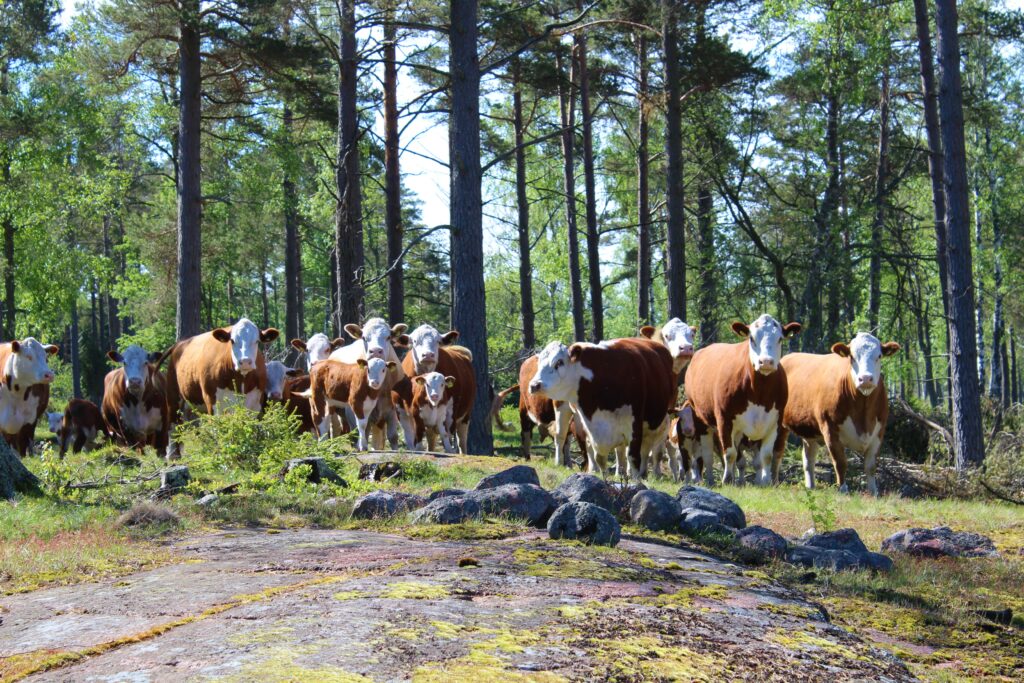Tage and Ulla Eriksson are reminded of their relationship with the Baltic Sea every time they step out their door. Established in 1726, Hammarudda Farm, with its long shoreline and barren cliffs, is surrounded by the sea in three directions. A unique location that also means signs of the sea’s health are hard to ignore.
The problem of eutrophication first became obvious to Tage and Ulla years ago, when they spotted blue-green algae blooms in the sea. Since their cattle often drink from the sea, they were afraid they might be harmed. “Husbandry is always challenging when it comes to balancing nutrient cycles”, says Tage. “You have to have very good manure management and be sure you have the right amounts of nutrients at the right time and in the right places.”
Our farming system is now fully adapted to our natural conditions.
Compounding the problem was the state of the soil – a nutrient-poor composition of light sand, moraine, and stones. By the time Tage and Ulla had taken over the farm in 1980, it had earned the nickname, “Hammarudda dirty sand,” Also, the pastureland was nearly nonexistent.
The work they have put in since then, however, has resulted in a complete transformation.

Efforts to reduce nutrient runoff consist of two main methods: Manure management and constructed ponds and wetlands. Manure is only spread during the growing season for maximum water protection. Two wetlands, and five ponds along the farm’s largest stream capture excess nutrients and sediments from the farm and forest, provide vital water reserves during droughts, and create habitats for wildlife.
Additional measures taken include soil mapping and almost year-round soil coverage. Nutrient-rich bladderwrack collected from the seashore is also added to the soil for fertilization and improvement.
Another significant change is the restoration of the farm’s natural grazing areas, which have grown from only 10 hectares in the 80s to over 90 hectares today of natural, permanent, biodiversity-rich pastures. Since the naturally thin soil is unsuitable for farming, to keep the grasslands open, continuous grazing is critical.
“We can now farm in a way where the animals mostly rely on pastures and we can have more cows than our fields would otherwise allow,” says Tage. “For half the year, the cows graze themselves. This way is more climate-friendly and our farming system is now fully adapted to our natural conditions.”
In 2019, Tage and Ulla Eriksson received the national Baltic Sea Farmer of the Year Award in recognition of their efforts to reduce nutrient runoff on their farm.
FARM FACTS
- Location: Åland island near south west Finland
- Type of farm: Organic/conventional livestock farm with forestry (350 ha)
- Main production: Nurse cows, Heifer breeding, fodder for own use, forest services and products, hunting and recreational activities
- Key practices: Buffer zones, catchment water bodies on the property including constructed ponds and wetlands, cover crops yearround, manure management, no chemical fertilizers or pesticides, preservation of trees, soil mapping and analysis
- National jury motivation: “The water protection measures at Hammarudda Farm are exceptionally comprehensive. The fields have plant cover for the greater part of the year. The farm aims to treat all surface waters that flow through it in some way with numerous voluntarily built wetlands and ponds. The usage of nutrients kept to a minimum and nutrient circulation is advanced. Extra points from the jury were given for significant work, since the 80s, to restore natural grazing areas. The area of natural grazing areas has increased from 10 to 90 hectares. The farm is managed as an entity and the farm constantly develops its methods. In addition, Hammarudda spreads knowledge of environmentally friendly methods to other farmers and stakeholders.”

